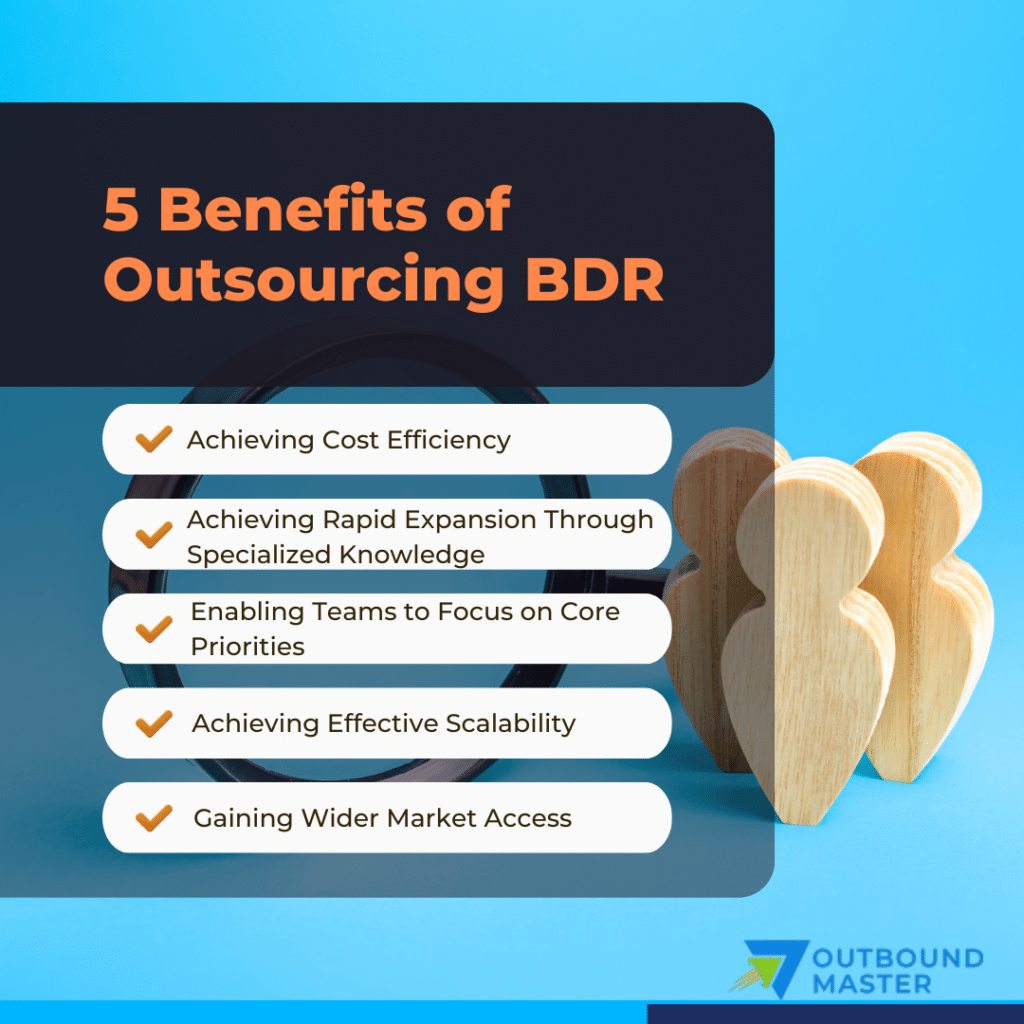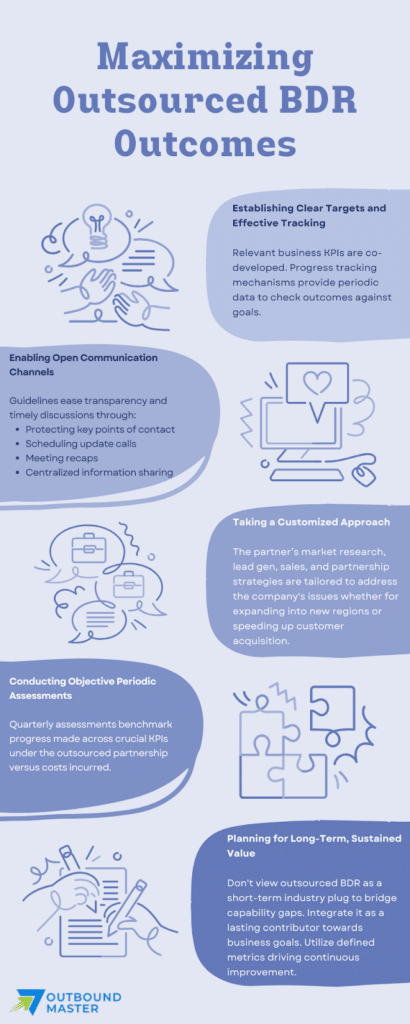Outsource BDR: The Ultimate Guide
BDR stands for business development representative. Outsourced BDR has become an integral strategy for companies looking to expand their horizons. The global spending on outsourcing is projected to reach $731 billion in 2023. As such, understanding this industry is key for modern businesses. This guide explores the following subtopics:
- The critical aspects of outsourced BDR
- Its myriad benefits
- How to select the ideal partner
- Making the most out of collaborations
- Overcoming potential pitfalls
Introduction to Outsourced Business Development
Business development represents activities aimed at growth through the following:
- Strategic partnerships
- Lead generation
- Market expansion
Outsourced BDR uses external expertise to achieve these goals with better efficiency and costs. As per ISG, 92% of G2000 firms already utilize IT outsourcing. This states the rising significance of external partnerships across functions.
Key Aspects of Outsourced BDR
Outsourced business development encompasses a wide range of specializations. BDR partners focus on them to catalyze growth for their clients. These key aspects include the following:
Conducting In-Depth Market Research
Expert BDR partners conduct extensive market analysis across factors like:
- Customer demographics and buying criteria
- Competitor landscape
- Distribution channel efficacy
- Pricing
- Emerging trends
These insights from research activities such as the following help clients craft growth roadmaps. They leverage market opportunities:
- Developing customer personas
- Performing competitor benchmarking
- Analyzing market segmentation
- Mapping the buyer journey
- Formulating market entry strategies
Driving Lead Generation and Management
Additionally, outsourced teams design dedicated lead generation strategies. These are powered by content, digital campaigns, events, referrals, and other modes. They identify and qualify high-intent prospects that fit the ideal customer profile. Lead nurturing and passing leads, to the sales team ensure that there is alignment with the sales pipeline. The main tasks involved in this process include:
- Creating lists of target accounts
- Developing customized content
- Managing campaigns
- Qualifying and evaluating leads
- Building the sales pipeline
- Establishing impactful strategic partnerships
Outsourcing partners provide opportunities for their clients to expand their reach through types of partnerships, such as channel partners, integration partners and joint go to market partners. They leverage their existing relationships and networks to identify partners analyze partnership opportunities negotiate contracts and maintain alliances.
Comprehensive marketing and sales support is provided by offering:
- materials
- Sales playbooks
- Campaigns
- Tools
- Templates
They speed up customer acquisition. Additionally, customer success planning retains accounts. The outsourced team’s activities encompass developing sales playbooks and creating content. They build sales tools, execute campaigns, and design customer success initiatives.
These four broad areas constitute aspects that enable outsourced BDR partners. They become invaluable catalysts for client growth:
- Specialized market research
- Lead generation
- Strategic alliances
- Marketing and sales support
Their methodologies, global networks, and industry expertise intersect. Together, they unlock tangible outcomes across these key facets.
Benefits of Outsourcing BDR
Outsourcing business development offers advantages for companies aiming for strategic growth. Some reasons behind outsourcing business development activities include;
Achieving Cost Efficiency
Outsourced functions help reduce costs in areas like HR, marketing, and lead generation. On average, they result in savings of around 27%. Specialist partners already possess the infrastructure, technology, and teams to carry out these processes efficiently at price points. Their economies of scale translate into expenses, for clients.
Achieving Rapid Expansion Through Specialized Knowledge
Partners fully commit their attention to fulfilling clients’ outsourcing needs. They possess, in-depth expertise, in niche industries, markets, and specific functions obtained through years of hands-on experience. By leveraging their proven methods and business development acumen they deliver expedited results. Moreover, they offer guidance to empower clients to seize opportunities and navigate challenges.
Enabling Teams to Focus on Core Priorities
Outsourced BDR lifts key yet non-core responsibilities off internal teams’ shoulders. It frees them to concentrate on mission-critical company priorities with maximum productivity. Executive teams can drive strategic decision-making and innovation. At the same time, sales teams focus on selling rather than lead generation.
Achieving Effective Scalability
The on-demand flexibility in scaling outsourced teams’ workload capacity ensures maintaining positive ROI. It applies even amidst fluctuating market conditions. Temporary or long-term capacity adjustments bridge labor gaps. They allow the pursuit of growth without excessive hiring/firing costs.
Gaining Wider Market Access
Partners’ extensive global networks and experience foster strategic alliances. These provide clients expanded brand visibility and access to the following:
- Previously untapped markets
- Customer segments
- Partnership opportunities they lack internally thus amplifying reach
These advantages show that outsourcing business development functions unlocks immense potential. It’s evident in terms of cost, productivity, innovation, and revenue gains.

Choosing the Right Outsourced BDR Partner
Selecting the optimal outsourced business development partner is pivotal. This is important in fully extracting value from the engagement. The ideal partner elevates across key aspects through specialized expertise. They use extensive networks and personalized collaboration. Comprehensively study potential partners based on crucial criteria. It’s key to identifying the best fit.
Assessing Relevant Experience and Expertise
Companies emphasize industry expertise as a top criteria in selecting outsourced partners. The partner must show success within the client’s market. This includes forming insightful intelligence on customers and competitors. Prior experience indicates the ability to deliver results in the client’s field.
Evaluating Methodologies and Technical Capability
62% of companies with outsourcing partnerships aim to access new technologies. They want people with new technical capabilities among their ranks. Examine the partner’s deployment of technology-powered proprietary approaches. It evaluates their ability to execute modern strategies.
Reviewing Demonstrable Case Studies and Track Records
Per Forrester, 74% of firms are ranking client references and track record as highly important in partner selection. The same firms also reported above-average outsourcing success levels. Analyze examples of the partner enabling lead generation, revenue growth, and market expansion. Doing this for clients validates their capability.
Structuring Robust Communication Channels
Deloitte notes that 70% of respondents cite poor communication as a top barrier in outsourced relationships. Partners should institute defined procedures for the following:
- Transparency
- Timely discussions
- Central points of contact right from the onset
Determining Cultural Alignment
Partnerships with strong cultural alignment are more likely to have above-average value realization. Shared values between partner and client reflected metrics like longevity and collaboration benchmarks. These help gauge fit.
Confirming Scalability and Flexibility
The partner’s ability to scale the following based on evolving workloads and requirements is tested by use cases. They confirm the dexterity to adjust to client or market changes:
- Teams
- Activities
- Pricing models
- Deliverables
Together, assess criteria like the following in the context of specific business objectives:
- Experience
- Capabilities
- Track record
- Communication structures
- Cultural match
- Agility
They aid companies in extracting high value from outsourced BDR partnerships, enabling growth.
| Factor to Check | Description | Check |
| Industry Expertise | Does the partner have a proven track record in your specific industry? | [ ] |
| Success Stories/Case Studies | Are there demonstrable success stories or case studies that showcase their effectiveness? | [ ] |
| Technological Proficiency | Does the partner utilize the latest technologies and tools for BDR? | [ ] |
| Communication and Reporting | Are their communication protocols and reporting mechanisms clear and efficient? | [ ] |
| Cultural Fit | Does the partner’s corporate culture align with your company’s values and work style? | [ ] |
| Customization Ability | Can they tailor their services to meet your specific business needs and goals? | [ ] |
| Scalability | Is the partner capable of scaling their services up or down based on your business needs? | [ ] |
| Cost-Effectiveness | Does the partner offer a cost structure that aligns with your budget and provides value? | [ ] |
| Client References and Reviews | Are there positive references or reviews from previous or current clients? | [ ] |
| Data Security and Confidentiality | Do they have robust measures in place to protect your data and intellectual property? | [ ] |
| Contract and Terms Clarity | Are the contract terms, conditions, and expectations clearly laid out and understood? | [ ] |
| Strategic Alignment | Does the partner understand and align with your long-term strategic goals? | [ ] |
Maximizing Outsourced BDR Outcomes
Strategically enhance an outsourced BDR partnership. It involves continuous collaboration towards defined growth objectives including:
Establishing Clear Targets and Effective Tracking
Relevant business KPIs are co-developed. They cover target market expansion, lead volume, sales cycle acceleration, and revenue growth. Progress tracking mechanisms provide periodic data to check outcomes against goals.
Enabling Open Communication Channels
Guidelines ease transparency and timely discussions through procedures like:
- Protecting key points of contact
- Scheduling update calls
- Meeting recaps
- Centralized information sharing
Taking a Customized Approach
The partner’s market research, lead gen, sales, and partnership strategies are tailored to address the company’s issues. It can be for expanding into new regions or speeding up customer acquisition.
Conducting Objective Periodic Assessments
Quarterly assessments benchmark progress made. It’s across crucial KPIs under the outsourced partnership versus costs incurred. Short-term course corrections or longer-term strategy pivots are driven by the data-backed review.
Planning for Long-Term, Sustained Value
Don’t view outsourced BDR as a short-term industry plug to bridge capability gaps. Integrate it as a lasting contributor towards business goals. Utilize defined metrics driving continuous improvement.

Expert Tips in Outsourced BDR
Industry specialists share best practices to optimize outsourced business development:
Match Partners to Specific Objectives
“Determine your exact outsourcing goals first. It can be lead generation, new market entry, or channel partnerships. Shortlist partners with proven success specifically in those areas.” – John Smith, BDR Consulting Firm CEO
Frequently Align on Expectations
“Align on expectations, desired outcomes, processes, and measurements. Accomplish this through open communication channels, outsourcing results improve by over 2X.” – Jane Hill, Outsourced Teams Director
Continuously Evaluate Performance
“Bi-weekly reviews of metrics-based partner performance is recommended. Do it across pipeline growth, deal velocity, and sales cycle effectiveness. Couple it with quarterly strategy alignment.” – Michael Chen, BDR Consultant
Leverage Specialized Partner Networks
“Great outsourced partners already possess extensive networks. Introduce them to your network to maximize reach.” – Sara Dillon, Business Growth Advisor
Leverage Specialized Partner Networks
“Great outsourced partners already possess extensive networks. Introduce them to your network to maximize reach.” – Sara Dillon, Business Growth Advisor
Common Pitfalls to Avoid in Outsourced BDR
While outsourced BDR enables tremendous growth, avoiding these frequent pitfalls is vital:
Cultural Alignment Cannot Be Overlooked
Differences in work culture between partner and client teams hinder collaboration and results. This includes communication, decision-making, and work styles.
KPI Establishment is Non-Negotiable
Don’t forgo quantifiable KPIs linked to lead volume, sales cycle, revenue expansion, and market access. This makes it impossible to track and optimize partnership ROI.
Comprehensive Contracts are Crucial
Failing to establish well-defined contracts means partners may not follow expected standards. This includes security, IPR, and transparency clauses.
Integration Planning is Key
Plan and test integration touchpoints between outsourced and in-house teams. This prevents operational gaps from impacting productivity.
Mitigate Over-Reliance Risks
While leveraging external expertise, keep some in-house capabilities. This ensures maintaining business continuity and oversight.
Conclusion
Outsourced business development has immense growth opportunities and complex nuances. It’s set to become even more critical for expanding companies in the future. This guide summarizes its multifaceted components. It ranges from its core aspects to top partnerships to maximizing its potential while overcoming pitfalls. By implementing these strategic perspectives, outsourced BDR can become a pivotal force. It will elevate your business to new heights.
Frequently Asked Questions
How does outsourced BDR sync with in-house teams?
Seamless collaboration between internal and external teams needs the following:
1. Cohesion in objectives
2. Transparency through open communication channels
3. Linking individual efforts to business outcomes
What are key partner selection criteria?
The following factors represent some vital evaluation parameters:
1. Industry expertise
2. Proven track records
3. Cultural alignment
4. Technical capabilities
5. Communication structures
6. Scalability
7. Pricing models
How can outsourced BDR ROI be measured?
Quantify results through growth KPIs across target areas associated with outsourced partner:
1. New markets accessed
2. Leads generated
3. Sales velocity
4. Revenue growth
Through its coverage of many facets of outsourced BDR, this guide provides actionable insights. You can harness external partnerships for business growth and competitive advantage. Evaluating options based on the outlined considerations will lead to optimal outcomes.



